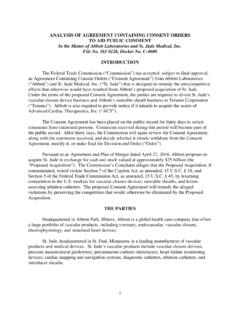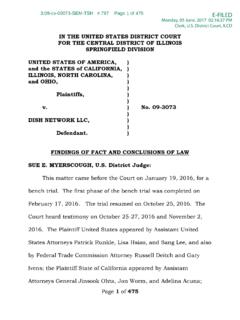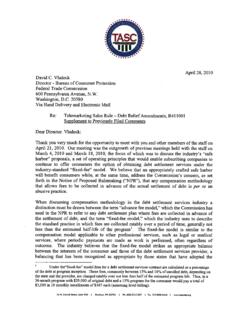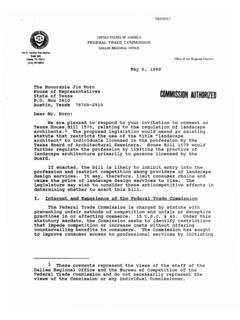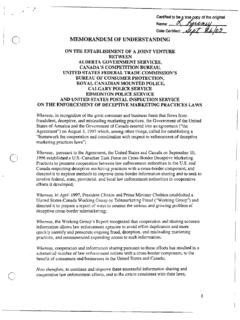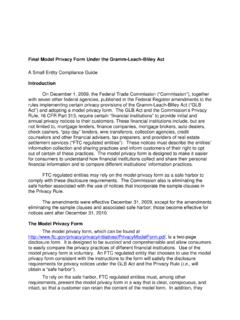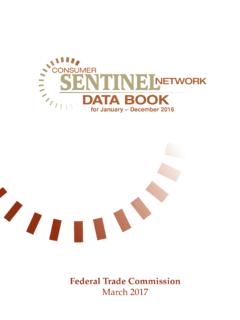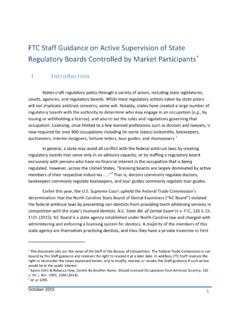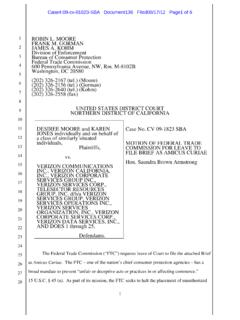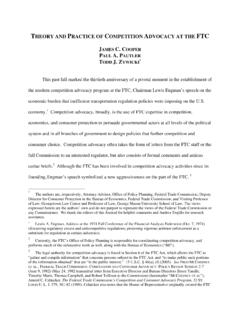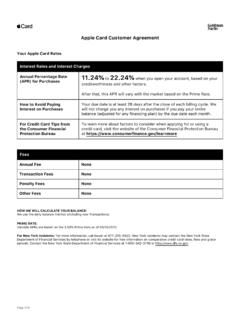Transcription of PROOF OF CONSUMER CREDIT INDEBTEDNESS
1 _____ _____ FEDERAL TRADE COMMISSION PROTECTING CONSUMERS IN DEBT COLLECTION LITIGATION ROUNDTABLE December 4, 2009 PROOF OF CONSUMER CREDIT INDEBTEDNESS DR. ERIC M. BERMAN, ESQ. Eric M. Berman, 500 West Main Street, Suite 212 Babylon, New York 11702 Table of Contents Executive Summary.. i 2 The CONSUMER CREDIT Transaction Complaint.. 3 Signatures.. 7 The Charge-off Balance Best PROOF of the Debt.. 01 The Right to Dispute the Debt.. 11 Account Stated.. 31 Real Party in Interest.. 71 Electronic Business Records.. 52 Asset Buyers and Electronic Business 72 Conclusion.. PROOF of CONSUMER CREDIT INDEBTEDNESS Dr. Eric M. Berman, Esq. Executive Summary 1. Introduction CONSUMER CREDIT INDEBTEDNESS occurs when a CONSUMER uses available CREDIT to make purchases, obtain services or take cash advances, and then fails to pay it back.
2 The failure of the CONSUMER to pay back the CREDIT as required by the CREDIT agreement can result in interest, fees and charges being added to the principal or actual amount spent, and creditors can and do sue consumers for unpaid balances and breaches of the CREDIT card agreement. The purpose of this White Paper is to explore the nature of the evidence of CONSUMER CREDIT INDEBTEDNESS and how it may be proven in court. 2. The CONSUMER CREDIT Transaction Complaint Creditors have the right to sue consumers to collect debts that are due and owing. Each state has its own standards of pleading, but the basic pleading standard was established by the United States Supreme Court in Bell Atlantic Corp. v. Twombly. The degree of factual specificity required, if any, to provide the defendant with fair notice of the relief demanded depends on the specific case and the specific cause of action being pled.
3 The issue is not whether a Plaintiff will ultimately prevail but whether the Claimant is entitled to offer evidence to support the claims. Current rules of court and pleading requirements are sufficient to protect consumers as well as permit creditors to collect the debts owed them. The following sections are devoted to the elements and issues of evidence that are often present in CONSUMER CREDIT litigation. -i 3. Signatures One of the elements of a contract is the use of a signature to signify the intent of the signor to enter into the agreement. In the middle ages contracts were signed by the inscription of a mark of some kind or an X . Embossed or formalized signatures came into existence as more people learned to read and write following the invention of the printing press.
4 We have now returned to the use of marks in place of signatures, but these marks exist in the form of electronic data which is submitted on-line or through other electronic or computer-generated means. CONSUMER CREDIT card applications and agreements no longer require signatures. Most consumers apply for and fill out their CREDIT applications via telephone or on-line eliminating the need for formal signatures or marks. The contract is created by the issuance of a CREDIT card and contract to a cardholder which the cardholder accepts each time he uses the card . The cardholder s use of the card , not his signature on a contract or application, accesses the CREDIT and creates the obligation to repay the CREDIT used plus contractual interest and fees.
5 4. The Charge-off Balance Best PROOF of the Debt Congress has pre-empted the regulation of CREDIT card issuers, believing such regulation to be necessary to insure national financial stability. A CREDIT grantor is not required to provide copies of individual transactions if it is not the entity providing the goods, services or cash advances. The monthly statement need only show the amount and date of the transaction, the name of the entity that provided the goods, services or cash advances, the city and state where the transaction took place, and the CREDIT card issuer must retain evidence of compliance for only two years after the disclosures were made. Federal Law requires that a lending institution charge-off the outstanding balance due and owing on a CONSUMER s CREDIT account when the CONSUMER is in continuous default for a -ii period of 180 days for open accounts including CREDIT card accounts, or 120 days for other CONSUMER CREDIT accounts such as retail installment agreements.
6 It is an accounting procedure in which the CREDIT card issuer absorbs the outstanding balance as a loss and takes the amount of the non-performing receivable as a charge against current earnings. The charged-off balance consists of all sums that are due and owing as of the charge-off date. It includes the amount actually expended by the cardholder for goods and services, all un reimbursed cash advances or transfers, and all interest, fees and charges as provided in the cardholder agreement. In essence, the charge-off balance is the total of all unpaid activity on the account as of the date of charge-off. Its use simplifies the process of proving the debt by eliminating the need to scrutinize account detail. 5. The Right to Dispute the Debt Consumers have the right to dispute any entry on their billing statements which they believe was made in error within sixty days following their receipt of each statement.
7 Lenders are allowed the presumption that any entry not disputed is correct and consumers are not relieved of their obligation to pay all undisputed entries. A CONSUMER s failure to make such payments on undisputed bills results in the default of the CREDIT agreement. 6. Account Stated An account stated is an agreed balance between the parties. It may be defined as an agreement, express or implied, between the parties to an account based upon prior transactions between them, with respect to the correctness of the separate items composing the account, and the balance, if any, in favor of the one or the other. A mere statement of a balance due including a monthly CREDIT card account statement, if accepted, is enough to constitute an account stated.
8 Once accepted, the statement becomes a new contract. -iii 7. Real Party in Interest A creditor which sues a CONSUMER to collect a debt must be the real party in interest. This means that the creditor is the party to whom the CONSUMER owes the debt. The PROOF of the real party in interest is straightforward if that party is the original creditor. The modern function of the rule in its negative aspect is simply to protect the defendant against a subsequent action by the party actually entitled to recover, and to ensure generally that the judgment will have its proper effect as res judicata. The issue of the real party in interest is largely a procedural requirement and should never become more important than the purpose which it seeks to accomplish.
9 When a CONSUMER s account is assigned or sold, a transfer of all the interests and rights to the account takes place. The assignee thereafter stands in the shoes of the assignor and may enforce the contract against the CONSUMER . Documentary PROOF is not necessary to establish an assignment when the allegations of such assignment in the complaint are not contested. A proper affidavit submitted with the application for a default judgment satisfies legal requirements and copies of the assignments are not required. Asset Buyers take the rights that their predecessors had and have the right to bring actions to collect the debts owed to their predecessors. 8. Electronic Business Records Business records establishing the claim need to be admitted into evidence to prove a CONSUMER CREDIT case.
10 An original creditor which sues a CONSUMER may enter its own business records into evidence to prove its case and can provide its own employee-witness to testify to its rights to the debt. If the owner of the account purchased that account, it is unlikely that there will be a witness from the original issuer. A representative from the current owner will need to -iv testify or submit an affidavit of the facts to prove that the current owner is the real party in interest; that the CONSUMER is the person who owed the debt to the original creditor and now to the current owner; and that the amount claimed to be owed is correct. Most financial business records are maintained on computers in various electronic formats. The maintenance and use of these electronic business records is governed by a plethora of Federal legislation including the Uniform Electronic Transactions Act.
